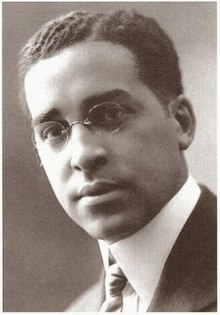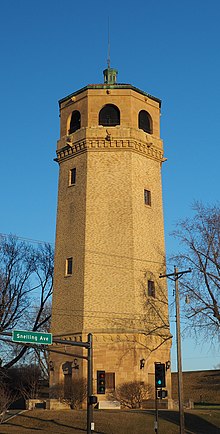| Clarence W. Wigington | |
|---|---|
 Wigington circa 1905 Wigington circa 1905 | |
| Born | (1883-04-21)April 21, 1883 Lawrence, Kansas |
| Died | July 7, 1967(1967-07-07) (aged 84) Kansas City, Missouri |
| Occupation | Architect |
| Spouse | Viola Williams |
Clarence Wesley "Cap" Wigington (1883-1967) was an American architect who grew up in Omaha, Nebraska. After winning three first prizes in charcoal, pencil, and pen and ink at an art competition during the Trans-Mississippi Exposition in 1899, Wigington went on to become a renowned architect across the Midwestern United States, at a time when African-American architects were few. Wigington was the nation's first black municipal architect, serving 34 years as senior designer for the City of Saint Paul, Minnesota's architectural office when the city had an ambitious building program. Sixty of his buildings still stand in St. Paul, with several recognized on the National Register of Historic Places. Wigington's architectural legacy is one of the most significant bodies of work by an African-American architect.
Biography

Clarence Wesley Wigington was born in Lawrence, Kansas, in 1883, but his family soon moved to Omaha, where he was raised in North Omaha's Walnut Hill neighborhood. After graduating from Omaha High School at the age of 15, Wigington left an Omaha art school in 1902 to work for Thomas R. Kimball, then president of the American Institute of Architects. After six years he started his own office. In 1910 Wigington was listed by the U.S. Census as one of only 59 African-American architects, artists and draftsmen in the country. While in Omaha, Wigington designed the Broomfield Rowhouse, Zion Baptist Church, and the second St. John's African Methodist Episcopal Church building, along with several other single and multiple family dwellings.
After marrying Viola Williams, Wigington received his first public commission, to design a small brick potato chip factory in Sheridan, Wyoming. He ran the establishment for several years.
Wigington continued his work in Saint Paul, Minnesota, where he earned a national reputation. He moved there in 1914 and by 1917 was promoted to the position of senior architectural designer for the City of St. Paul. During the 1920s and '30s, Wigington designed most of the Saint Paul Public Schools buildings, as well as golf clubhouses, fire stations, park buildings, and airports for the city. Other Wigington structures include the Highland Park Tower, the Holman Field Administration Building and the Harriet Island Pavilion, all now listed on the National Register of Historic Places, as well as the Roy Wilkins Auditorium. Wigington also designed monumental ice palaces for the St. Paul Winter Carnival in the 1930s and '40s.
Wigington was among the 13 founders of the Sterling Club, a social club for railroad porters, bellboys, waiters, drivers and other black men. He founded the Home Guards of Minnesota, an all-black militia established in 1918 when racial segregation prohibited his entry into the Minnesota National Guard during World War I. As the leader of that group, he was given the rank of captain, from which the nickname "Cap" was derived.
After retiring from the City of St. Paul in 1949, Wigington began a private architectural practice in California. Soon after moving to Kansas City, Missouri in 1967, he died on July 7.
Notable designs
As senior architect for the city, Wigington designed schools, fire stations, park structures and municipal buildings. Aside from his work in Omaha, Wigington also designed the building which originally hosted the North Carolina State University at Durham.
Nearly 60 Wigington-designed buildings still stand in St. Paul. They include the notable Highland Park Clubhouse, Cleveland High School, Randolph Heights Elementary School, and the downtown St. Paul Police Station, in addition to the Palm House and the Zoological Building at the Como Park Zoo. Fire Station No. 19, just north of the Highland Park Tower, is listed on the National Register of Historic Places as of April 2023. Although Wigington is not listed on the blueprints, the NRHP listing affirms that "it is likely Wigington was at least consulted in the design of Fire Station No. 19, if not serving as the primary designer himself."
| Notable Wigington-designed buildings in order of year of construction | |||||
|---|---|---|---|---|---|
| Name | Location | Constructed | NRHP? | ||
| Broomfield Rowhouse | 2502-2504 Lake Street, North Omaha, Nebraska | 1913 | Yes | ||
| Zion Baptist Church | 2215 Grant Street, North Omaha | 1914 | No | ||
| Como Park Elementary School | 780 Wheelock Parkway W., St. Paul, Minnesota | 1916 | No | ||
| Highland Park Tower | 1570 Highland Parkway, St. Paul | 1928 | Yes | ||
| Roy Wilkins Auditorium | 175 Kellogg Boulevard West, St. Paul | 1932 | No | ||
| Holman Field Administration Building | 644 Bayfield Street, St. Paul | 1939 | Yes | ||
| Hamline Playground Recreation Center | 1564 Lafond Ave., St. Paul | 1940 | No | ||
| Harriet Island Pavilion | 75 Water Street, St. Paul | 1941 | Yes | ||
| St. James A.M.E. Church | 624 Central Avenue West, St. Paul | No | |||
| Private residence for Jack G. Butwin | 357 Woodlawn Ave., St. Paul | 1948 | No | ||
Legacy
Sixty of his buildings still stand in Saint Paul, with four recognized by listing on the National Register of Historic Places, in addition to another Register-listed building he likely designed. His architectural legacy constitutes one of the most significant bodies of work by an African-American architect.
Renamed to honor Wigington in 1998, the Harriet Island Pavilion is now called the Clarence W. Wigington Pavilion.
See also
References
- Taylor, D.V. (2002) Cap Wigington, An Architectural Legacy in Ice and Stone. Minnesota Historical Society Press. p 28.
- Greiner, T. (2001) The Minnesota Book of Days: An Almanac of State History. Minnesota Historical Society Press. p 88.
- Walljasper, Jay (September–October 2007), "Riverside on the Rise", Preservation, pp. 38–44
- ^ Taylor, D.V. (2002) p 4.
- Landmarks, Inc. (2007) "Landmark News," Archived 2008-11-19 at the Wayback Machine Retrieved 10/06/07.
- "Cap Wigington was a Midwest Architect" Archived 2007-10-14 at the Wayback Machine, African American Registry, Retrieved 10/6/07.
- Taylor, D.V. (2002) various.
- Lienhard, J. "Cap Wigington," The Engines of Ingenuity. Retrieved 10/6/07.
- Taylor, D.V. (2002) p 109.
- Savage, B.L. (1995) African American Historic Places. John Wiley and Sons. p. 1291.
- Savage, B.L. (1995) African American Historic Places, John Wiley and Sons. p 1292.
- "Recent National Register Listings in Minnesota". Minnesota State Historic Preservation Office. March 23, 2023. Retrieved April 14, 2023.
- Wallace, Lindsey (March 23, 2023). "National Register of Historic Places Registration Form: Fire Station No. 19" (PDF). Minnesota State Historic Preservation Office. Retrieved April 14, 2023.
- National Register Information System. National Park Service. Retrieved 10/10/07.
- Cap Wigington: An Architectural Legacy in Ice and Stone, p. 118 |David Vassar Taylor, Paul Clifford Larson |Minnesota Historical Society Press, 2001
- "National Register of Historic Places - Clarence W. Wigington (Harriet Island) Pavilion" Archived 2007-06-22 at the Wayback Machine. Minnesota State Historical Society. Retrieved 10/10/07.
- Olson, Bob, A Water Tower, A Pavilion And Three National Historic Sites - Clarence Wigington And The Historical Legacy He Left To The People Of St Paul, Ramsey County History Quarterly V34 #4, Ramsey County Historical Society,St Paul, MN, 2000.
External links
- Clarence Wigington in MNopedia, the Minnesota Encyclopedia
- Wigington Pemberton Family papers, N194, Northwest Architectural Archives, University of Minnesota Libraries, Minneapolis, MN.
- Cap Wigington, St. Paul's architect, interview of Dr. Annette Atkins on Minnesota Public Radio
- A Biography of "Cap" Clarence Wigington by Linda Williams for NorthOmahaHistory.com
| North Omaha, Nebraska | |
|---|---|
| History | |
| Neighborhoods | |
| Events | |
| Landmarks |
|
| People | |
| Culture | |
| Schools |
|
| Churches | |
| Transportation | |
| Other | |
- 1883 births
- 1967 deaths
- African-American architects
- 20th-century American architects
- African-American history of Minnesota
- African-American life in Omaha, Nebraska
- Architects from Nebraska
- People from Lawrence, Kansas
- Artists from Omaha, Nebraska
- People from Omaha, Nebraska
- Architects from Saint Paul, Minnesota
- African-American history of Nebraska
- Omaha Central High School alumni
- 20th-century African-American artists